Neyci Estefanía Gutiérrez Valencia
“Is this Patagonia? And if this is Patagonia, what am I?”
César Aira, La costurera y el viento
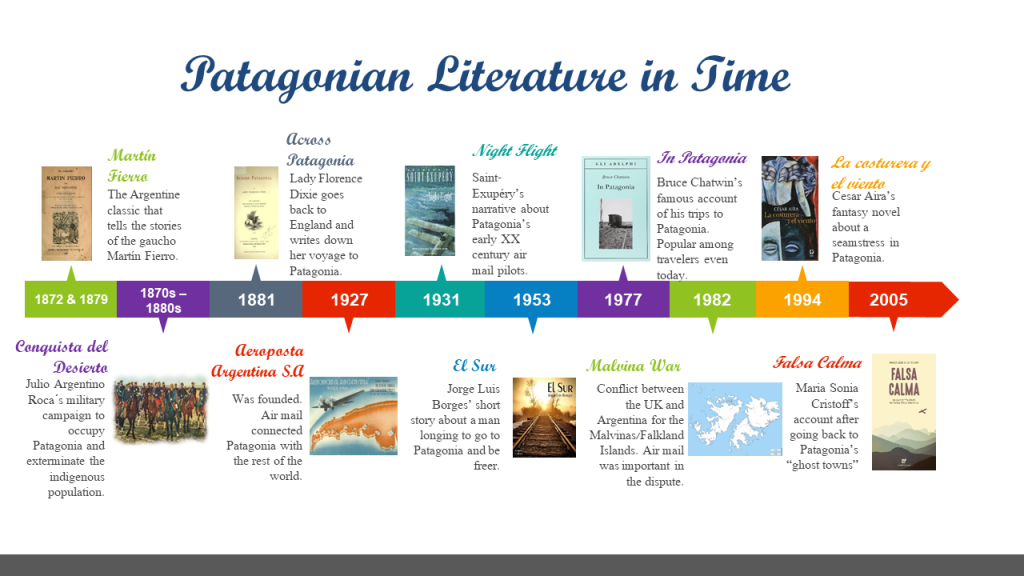
Patagonia, the land at the end of the world, has captivated the imagination of writers around the globe, driving their pens and enthralling their readers. One of the most well-known accounts is Bruce Chatwin’s In Patagonia, where the main character embarks on a journey across Patagonia interviewing dwellers along the way. However, as verosimile as this account is, there are many aspects that deviate from reality significantly, which many readers that have incorporated Chatwin’s descriptions into their imaginary may find shocking. Another famous work about Patagonia is El Sur by Jorge Luis Borges. This short story begins with the character’s longing for the South, a place of liberation and freedom, an idea that has long been present in Argentine tradition, starting from the classic Martín Fierro.
Even though Patagonia is usually treated as a land beyond control and conventional social norms, there is a contrast between the approach Argentine writers and English writer Bruce Chatwin have: Chatwin depicts Patagonia as a place populated and civilized by foreigners, whereas famous Argentine authors have used it as a representation of freedom and opportunity. While this region has harnessed the fascination of many around the world, there is no specific critic body that analyzes these narratives as a whole, and thus there are few that have compared how authors have used the image of Patagonia. This paper explores the main similarities and differences between lesser known works on the region, including Night Flight by Antoine de Saint-Exupéry, Falsa Calma by Maria Sonia Cristoff and La costurera y el viento by César Aira.
One common characteristic found in these texts, even if they do not fit into the travel narrative genre strictly, is the theme of travel. Texts that

follow journeys have nurtured the “nomadic imagination” (Nouzeilles 199-200) of earnest adventurers around the globe who relish on the possibility of going back home to tell their stories of remote places like the characters in such narratives. This is not a new phenomenon: Lady Florence Dixie wrote accounts of her voyages as early as 1880. Whenever someone visits a place, the narrations about it come to mind and their perception of the place becomes an “[i]nterplay of [their] imagination with geographical myths” (Nouzeilles, 35-48). This essay shall look at how the authors construct their literary journeys to Patagonia through landscape descriptions, the structure of the journey itself and the characters that inhabit their tales.
Night Flight is the story about Fabien, a pilot, and his superior, Riviére, who operates air mail in Patagonia. The book draws inspiration from Exupéry’s experiences at the front of Argentina Aeroposta. Published in 1931, almost 50 years after the Conquest of the Desert, the military occupation campaign, and 50 before Chatwin’s In Patagonia, the text still has colonial undertones present in Exupéry’s word choices in descriptions.
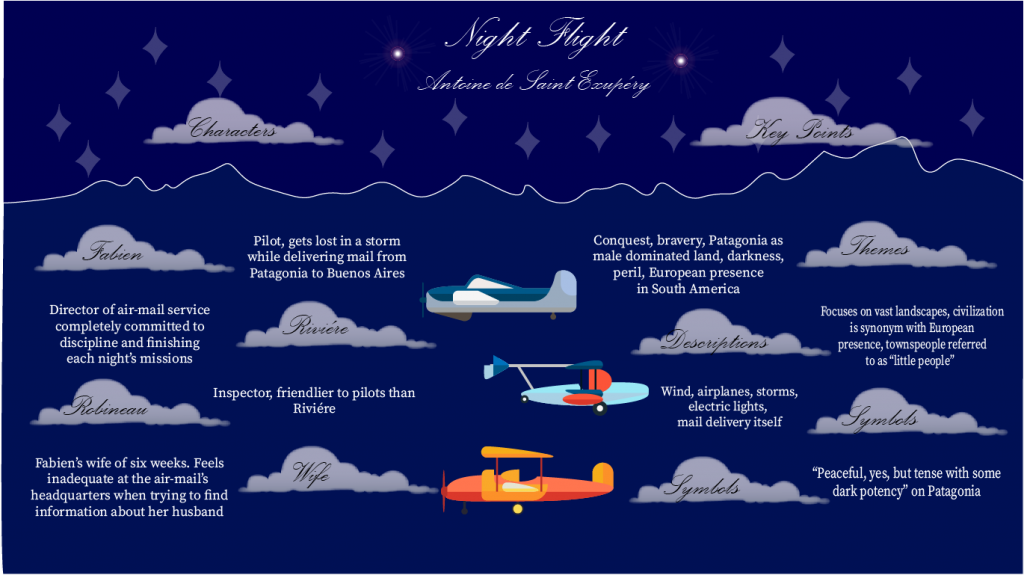
Falsa Calma is a non-fiction book written by Maria Sonia Cristoff in 2005 about the lives of people in “ghost towns” in Patagonia. The author, who is also the narrator, intends to function as a medium for the people in these ghost towns to tell their stories. The narrator portrays the everyday struggles of people living in these towns, especially those arising from their relationship to their town’s isolation. Originally from Patagonia, Cristoff writes about it from outside her own homeland and tries not to follow “in the line of Chatwin’s creation of myths”, demystifying the land and its people.
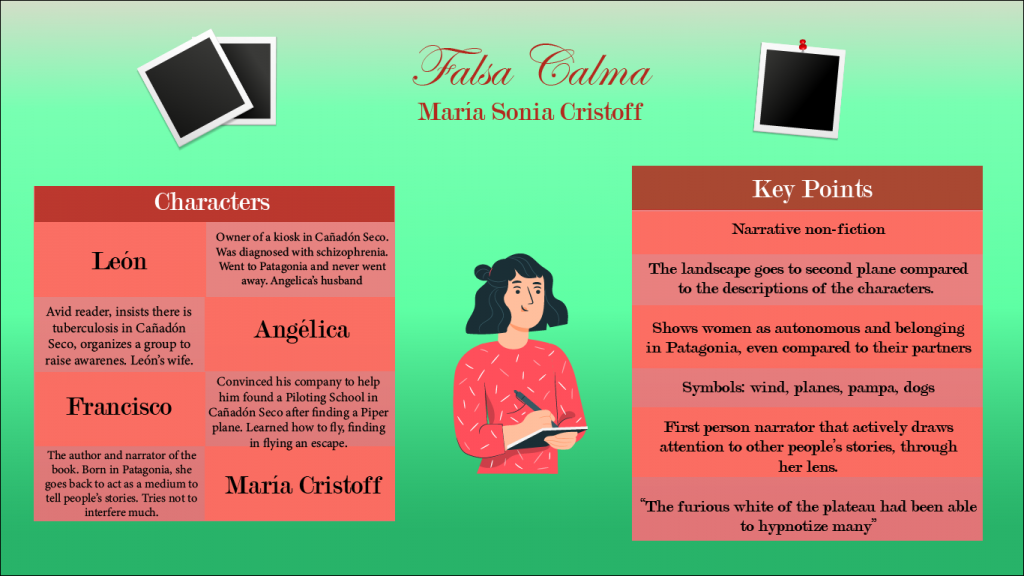
César Aira is an author from Buenos Aires who wrote La costurera y el viento in 1994. The narrator is the author’s namesake, a resource commonly used by Aira in other texts. The main character is a seamstress who is taken to Patagonia when looking for her disappeared child. Through symbols and characters, Aira places women and femininity in the traditionally male-dominated Patagonian landscape, like Lady Florence Dixie and Maria Sonia Cristoff do.

T ravel narrative
The term travel narrative is used to describe literature that portrays an individual leaving their everyday environment and going to a place that is often remote or mysterious in search of adventure. Travel narrative is so ingrained in literary tradition that is often presented as the “model narrative” (Mikkonen, 286). This kind of text is usually written from the perspective of individuals that are “limited to a certain social class […] not only because they need the means to finance the trip [but also] the intellectual formation to articulate their vision” (Livon Grosman). The authors for all three texts have the means to express their viewpoint of Patagonia from an outsider’s perspective, even if they are not all outsiders in the same way.

Maria Sonia Cristoff´s account adheres to some of the conventions of travel narratives. She grew up in Patagonia and went back to write Falsa Calma. Even so, she recognizes that people from Cañadón Seco felt “the need to expel the intruder” (Cristoff, 51) after she had spent too much time there and the initial curiosity about her presence had subsided. Therefore, she recognizes that her experience was limited due to her condition as a visitor, someone who inevitably has to leave. However, she subverts the notion of travel narratives as opportunities for adventure, as she travels to portray everyday life in Patagonia. Therefore, this modern non-fiction narrative attempts to introduce readers to an aspect of the legendary land that is often overlooked: the people that “[went] to Patagonia and never [came] back” (Cristoff, 28).
Exupéry and Aira focus more on traditional adventures. In La costurera y el viento, the narrator explains how French people gasp at the mention of Patagonia, where “all adventures could happen” (Aira, 19). Aira implies he has completed the last stage of the travel narrative: going back and telling others about the journey. However, the narrator is not part of the main events in the novel’s plot. In fact, he implies that the main characters will never be able to get out of Patagonia: for Delia, the seamstress, it was “impossible to think that she would ever get out of there” (Aira, 30) Moreover, Aira affirms that a trip is only “bearable when it is in significant” (Aira, 19), and given that the characters in the novel have been transformed deeply by their trip to Patagonia, it is likely that they would not be able to go back to Coronel Pringles. Therefore, Aira challenges the
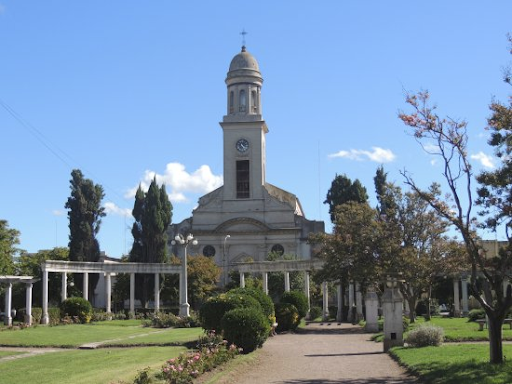
idea of people being transformed by Patagonia when they have the option to leave, proposing that the only true way to be transformed by a journey is to never leave the place one goes to, never having the choice to return.
Exupéry shows the characters embarking on several journeys throughout the novel, with the most important one being the night when Fabien goes missing. In this case, the danger travelling entails is justified by the need, or ambition, of bringing air mail to Patagonia even if it requires some sacrifices; they are willing to send people out on missions during a cyclone because “cyclones never cross the Andes” (Exupéry, 34) The journey also has eurocentric and colonialist undertones, as the narrator often explains that Riviére sees mail delivery as “cities falling one by one before a conqueror” (Exupéry, 59). Given the novel’s purpose is to pay homage to the bravery of pilots delivering airmail, Exupéry’s decision to highlight the difficulties theyfaced during their journeys and comparing their deeds to conquest is
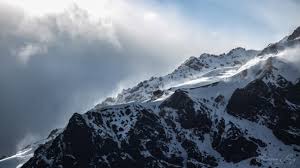
reasonable: it would help people recognize their labour, even if it meant portraying Patagonia as an uninhabited, inhospitable land. Nevertheless, it is inevitable for the reader of Exupéry’s novel, or of the other two texts, to unconsciously Patagonia with their readings.
Landscapes
For Exupéry, the landscape is “uninhabited, […] the pin-points of ‘civilisation’ visible to the pilot […] reinforced a sense of the sparse scattering of European settlers across their colonies.” From the
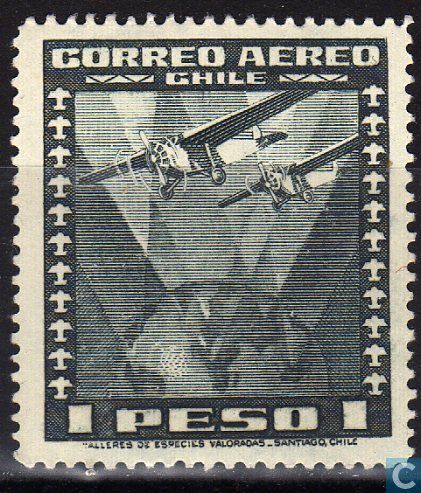
aeroplane from which Fabien looks at Patagonia, the only visible traces of human activity are related to Europeans. The author frequently highlights the pristineness and alluring danger that Patagonia represents stating it is “peaceful, yes, but tense with some dark potency” (Exupéry, 27). The land’s metaphorical and literal darkness is thus contrasted with the light from the European settlements, which constitute the only human settlements the narrator acknowledges.
In contrast, Maria Cristoff offers a more personal view. Mountains and tiny villages in the distance are replaced by descriptions of Cañadón Seco: its bus stops, kiosks and parks. The only time the greater
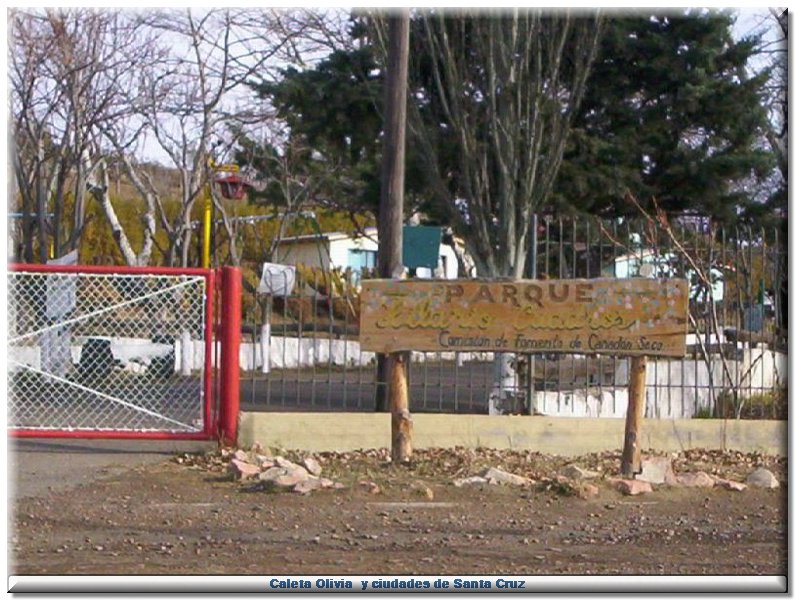
Patagonian landscape is described with a visual image it is to heighten the feelings of Francisco, the plane pilot: “the blue sky and white ocean contrasted with the feeling of fear: Patagonia, unmovable by fear nor human change” (Cristoff, 39). The contrast between the feelings of the pilot and the calm appearance of the Patagonian landscape is entirely different from Exupéry’s approach, where Fabien’s emotions match his tempestuous surroundings. In Cristoff, Patagonia’s impassivity gives meaning and significance to its title: Falsa Calma. Even if Patagonia’s landscape does not reflect it, the people living in it struggle constantly.
Aira differentiates himself from the others by not describing landscapes in detail. In La costurera y el viento, Patagonia appears to be a symbolic space. While Aira uses toponyms to situate the reader in the geographic space of Patagonia, he hyperbolizes its vastness and emptiness, calling

it the “biggest place of all” (Aira, 80). Not only are visual images of Patagonia scarce, but those that exist oftentimes contradict each other. Delia sees a moonless night; her husband observes a full moon. This means Patagonia, in its blank slate, can transform people in entirely different ways. This is similar to how authors have produced dramatically different accounts of Patagonia.
The three stories use the symbol of the wind with different purposes. In Night Flight, the wind serves as a device for creating tension during the passages describing Fabien’s flights and is often seen as the adversary who “[buffets] him […] from side to side” (Exupéry, 28), eventually leading to his disappearance. The wind, a symbol representative of Patagonia itself, is consequently an obstacle for Riviére and the pilots to achieve their goal of establishing Patagonia Mail, thus showing the wilderness of Patagonia as a downside for the people who try to civilize it.
In Falsa Calma, wind plays less of a prominent role, but mentioned constantly when related to isolation. The pilot explains that he can constantly hear the wind at night, reflecting the deserted surroundings of his house. Thus, it presents the loneliness caused by living in one of the ghost towns of Patagonia as being a direct result of the landscape and climate. This brings attention to how the wind, a motif that evokes awe inspiring images in a visitor’s mind, changes when seen through the lens of a local.
Aira is perhaps the one that uses the symbol of the wind to change the image of Patagonia the most. While Patagonia is often seen as a timeless, unchanging land beyond the frontiers of the world, Aira states that “the end of the world is still part of the world” (Aira, 24), and so treats the region as a place where change is not only possible but constant. The wind, years before the main events of the novel, offers a snowman immortality if it agrees to be “shaped forever, at every instant, by us, the wind” (Aira, 78) The idea of the wind as a force that would perpetually change the landscape goes against Patagonia’s image as a “primordial, pre-historical space” (Nouzeilles, 36) where change is impossible. This is a metaphor for how Patagonia’s political, cultural and, eventually, touristic relevance has changed over the course of two centuries.
The authors’ contexts are ingrained in their work: during Exupéry’s times, Patagonia was not a center for tourism yet and colonizing or modernising the land was still a major concern, which explains why natural features constantly contrast with the few European towns in sight. When Cristoff wrote Falsa Calma, there was already a booming hospitality industry in the region. As such, her decision to portray the less glamorous aspects of Patagonia attempts to inform readers about what they might not have been able to see during their time as tourists. Aira, finally, follows in Borges’s footsteps by using toponyms and general descriptions to imbue Patagonia with a sense of freedom, transformation and opportunities, which could be seen as a response to the vastly different works that take Patagonia as an inspiration.
The People of Patagonia
Authors such as Jorge Luis Borges have often written about gauchos, the cowboy-like figures that inhabit Argentina’s pampas. These people have been in the collective imagination of both locals and visitors as the inhabitants of Patagonia ever since, especially fueled by classic Argentine works such as Martín Fierro, developing Patagonia’s image as a male-dominated land. However, these texts show a different side of the people in Patagonia.
Night Flight’s main characters all have French names, such as Riviére and Pellard. Their relationships with the people living in Patagonia´s town shows a difference in how the narrator sees them. For once, the locals were the only ones ever described as miniature, and Riviére even thinks that “the little people of these little towns, strolling around their bandstands, might seem to live a placid life yet it had its tragedies” (Exupéry, 69). The people living in the town are not only not central to the story the book

narrates, but the characters seem to see them as lesser than themselves. Another group not prominently featured in the novel are women. In fact, their inadequacy in Exupéry’s Patagonia is expressed by Fabien’s wife, who feels “her presence here misplaced, indecent” (Exupéry, 167). Thus, while the characters might not be gauchos, they follow the idea of a male-dominated Patagonia.
Cristoff, on the other hand, gives women and the “little people” the spotlight. The structure of the text supports this intention, as in each chapter she focuses on a different group of people living in the Patagonian ghost towns. She tells their stories, from an elementary school reunion to Francisco’s attempt to learn how to fly as a way of avoiding his “pacts, commitments and relationships” (Cristoff, 35). Her descriptions of women are starkly different from Exupéry’s, as exemplified when she portrays Leon, a kiosk owner, as passive and contemplative compared to her proactive wife who takes part in demonstrations and protests. Thus, Cristoff’s Patagonia focuses on groups that are traditionally left out of people’s collective Patagonian imagination: locals that are not gauchos and women.
Aira’s stance is similar to Cristoff’s, using symbols that help emphasize the power dynamics between different groups in Patagonia. While Delia is initially confined to her house and her role as “gossip woman” (Aira, 34) in Pringles, Patagonia enables her to become an adventurer. This is similar to how Victorian women such as Lady Dixie Florence saw Patagonia as a
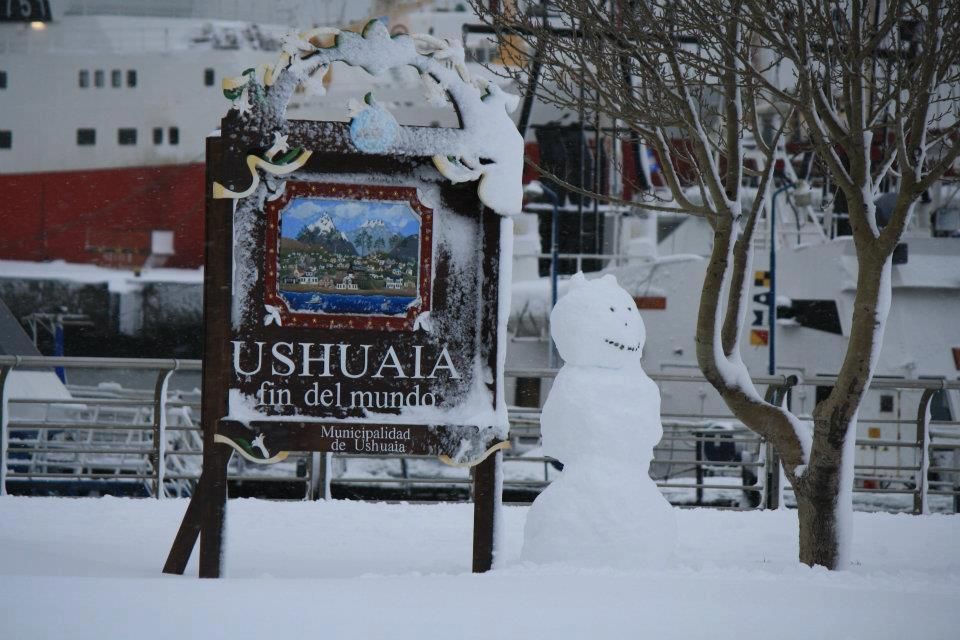
way to stop being “damsels in distress at the mercy of hostile Elements” (Martín, 58). Other characters also embrace traditionally female symbols, like the snowman wearing the wedding dress that the wind took away from Delia. This challenges the idea of a male-dominated Patagonia. However, duels between men are still present in the form of gambling, which seems to suggest that Aira has taken some elements traditionally related to Patagonia and adapted them to a new context to show Patagonia’s evolution.
Conclusion
It is inevitable for three texts from vastly different categories to vary in style and specifics. However, the way they portray Patagonia inside their respective genres says a lot about what Patagonia means for each. This, in turn, affects how their contemporary and future readers will form their image of the region. Patagonia is often associated with war and wilderness due to the resistance of native tribes to the brutal displacement caused by the Argentine state. Thus, it is not surprising that the concept of rivalry between civilization and Patagonia would carry on to Exupéry’s early XX century novel, especially when treating topics such as the metaphorical conquest of the land. Exupéry’s novel is the one closest to Chatwin’s account, published forty years later.
Aira and Cristoff, both Argentine and closer to the present day, have a starkly different treatment from Exupéry. They both deal with the struggles of locals and challenge the male gaze and dominance on the land, but try to subvert the image of Patagonia in different ways. Aira is interested in the literary representation itself, as seen in his highly symbolic treatment of the landscape and the use of the dress and the wind as essential motifs in the narrative that represent both the ever-changing nature of Patagonia and the possibility for women to detach themselves from gender stereotypes in it. On the other hand, Cristoff , being from Patagonia herself, tries to forget the mythical land that has been woven throughout two centuries of narratives altogether and focuses on the real people living in Patagonia, those forgotten even as the interest in the region grows.
In conclusion, Patagonia has inspired a wide range of authors throughout time. Literary representation is important due to its effect on how people approach a place: people still read Chatwin before making the trip to the South and have a preconceived image of the pampas before even setting foot on them. Aira and Cristoff show that representations of Patagonia are becoming increasingly diverse, when compared to predecessors like Exupéry. Consequently, interest in areas of the region previously neglected might increase, even attracting the attention from and to groups that have long been denied a voice in the land at the end of the world.
Where is Literature?

A map that represents the places in which the characters of the three books explored Patagonia. In pink: Aira’s Delia Siffone. In blue: Exupéry’s Fabien. In yellow: María Sonia Cristoff.
Further reading and sources:
Aira, César. 1994. La costurera y el viento. 1. ed. Ficciones (Rosario, Argentina). Rosario [Argentina]: B. Viterbo Editora.
Borges, Jorge Luis. 1971. Ficciones. El Libro de bolsillo ; 320. Sección: Literatura. Madrid: Alianza Editorial.
“Bruce Chatwin: la corriente ancestral.” n.d. Accessed April 15, 2020. https://www.nexos.com.mx/?p=9423.
Chatwin, Bruce. 1977. In Patagonia. New York: Summit Books.
Courtivron, Isabelle de. n.d. “At Home in the Air.” The New York Times. Accessed April 28, 2020.
https://archive.nytimes.com/www.nytimes.com/books/97/08/17/nnp/17682.html.
Cristoff, María Sonia. 2005. Falsa calma : un recorrido por los pueblos fantasma de la Patagonia. 1. ed. Crónicas (Buenos Aires, Argentina). Buenos Aires: Seix Barral.
Daley, Ben. 2009. “Writing from above: Representations of Landscapes, Places and People in the Works of Antoine de Saint-Exupéry.” Journal of Cultural Geography 26 (2): 127–47. https://doi.org/10.1080/08873630902989806.
Dixie, Lady Florence. 2012. “From Across Patagonia.” Review: Literature and Arts of the Americas 45 (1): 64–69. https://doi.org/10.1080/08905762.2012.670460.
Fontaine Talavera, Arturo. 1999. “Bruce Chatwin: La Corriente Ancestral.” Nexos: Sociedad, Ciencia, Literatura, October 1999. Gale Literature Resource Center.
Hasbrouck, Alfred. 1935. “The Conquest of the Desert.” The Hispanic American Historical Review 15 (2): 195–228. https://doi.org/10.2307/2506294.
Livon-Grosman, Ernesto, and Ernesto Livon Grosman. 2001. “Lo abierto y lo cerrado: El espacio patagónico en la literatura de viaje.” Ciberletras 5 (January).
“Los viajes de Saint-Exúpery.” 2018. viajes.nationalgeographic.com.es. July 31, 2018. https://viajes.nationalgeographic.com.es/a/viajes-saint-Exupéry_13018.
“María Sonia Cristoff.” 2011. September 28, 2011.
https://web.archive.org/web/20110928073300/http://www.mertin-litag.de/authors_htm/ Cristoff-M.htm.
Martin, Claire Emilie. 2012. “‘Shall I Ever Climb the Moors Again?’ : Lady Florence Dixie’s Across Patagonia (1880).” Review: Literature and Arts of the Americas 45 (1): 57–63. https://doi.org/10.1080/08905762.2012.670458.
Mellado, Luciana. 2012. “La Costurera y El Viento by César Aira: The Patagonia like Textual Corpus.” Alpha (Osorno), no. 34 (July): 63–76. https://doi.org/10.4067/S0718-22012012000100005.
Mikkonen, Kai. 2007. “The ‘Narrative Is Travel’ Metaphor: Between Spatial Sequence and Open Consequence.” Narrative 15 (3): 286–305.
Nouzeilles, Gabriela. 1999. “Patagonia as Borderland: Nature, Culture, and the Idea of the State.” Journal of Latin American Cultural Studies 8 (1): 35–48. https://doi.org/10.1080/13569329909361947.
Robles, Edgar. n.d. “Ensayos críticos sobre César Aira.” Accessed April 28, 2020. https://www.academia.edu/35352221/EnSAyoS_cR%C3%8DTIcoS_SobRE_c%C3%A 9SAR_AIRA.
Ruiz, José Barrena, Machiel Lamers, Simon Bush, and Gustavo Blanco Wells. 2019. “Governing Nature-Based Tourism Mobility in National Park Torres Del Paine, Chilean Southern Patagonia.” Mobilities 14 (6): 745–61. https://doi.org/10.1080/17450101.2019.1614335.
Saint-Exupéry, Antoine de. 1932. Night Flight. Paris: Crosby Continential Editions.
Writing Travel : The Poetics and Politics of the Modern Journey. 2008. DesLibris. Books Collection. Toronto [Ont.]: University of Toronto Press.
{“http://www.deslibris.ca/ID/430889″:[“www.deslibris.ca“]}.
Yolis, Máximo. 2014. “Del gaucho literario al gaucho ‘real’: un aporte a su construcción en Argentina (1845-1913).” História da Historiografia: International Journal of Theory and History of Historiography 7 (16): 15–36. https://doi.org/10.15848/hh.v0i16.845.

